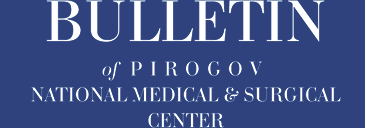Authors
Aslanov A.D.1, 2, Kalibatov R.M.1, 3, Logvina O.E.1, Kardanova L.Yu.1, 2, Belgarova D.T.1, Gotyzhev M.A.1, 2, Baksanokov Z.H.5, Bakov Z.N.4, Zhirikov A.V.1
1 Kabardino-Balkarian State University named after H.M. Berbekov, Nal’chik
2 Republican Clinical Medical and Surgical Center of the Ministry of Health of the KBR, Nal’chik
3 Ministry of Health of the Kabardino-Balkarian Republic, Nal’chik
4 Republican Clinical Multidisciplinary Center of High Medical Technologies of the Ministry of Health of the KBR, Nal’chik
5 Central district Hospital of the Tersk district, Terek
Abstract
Backgraund: In recent decades, the number of patients with acute mechanical jaundice has increased significantly. Routine use of endoscopic retrograde cholangiopancreatography improved the results of treatment of patients with obstructive jaundice.
Aims: The aim of this study is to identify risk factors for the development of acute pancreatitis after ERCP, as well as to analyze the relationship with individual anatomical features and intraoperative characteristics.
Materials and methods: The data of 402 patients without cholangitis clinic and without increased amylase levels at the time of hospitalization were analyzed according to laboratory examination data. The patients were divided into 2 groups: the first – those observed after ERCP without complications, the second – patients who developed an acute pancreatitis clinic.
Results: In the examined sample, 9.7% of cases of acute pancreatitis were detected, which is a fairly average indicator. The results of the comparative analysis indicated a combination of the influence of factors of anamnesis, anatomy and actions of endoscopists during the ERCP manipulation.
Conclusions: The data obtained prove that the correct actions of the attending physician, consideration of risk factors and the experience of the endoscopist play a leading role in the results of treatment of patients with obstructive jaundice.
Keywords: mechanical jaundice, cholangiopancreatography, endoscopic retrograde, acute pancreatitis..
References
1. Kletsko IY, Kushniruk AI. Risk factors of acute pancreatitis after therapeutic endoscopic retrograde cholangiopancreatography. News of Surgery. 2018; 26(3): 301-310. (In Russ.) doi: 10.18484/2305-0047.2018.3.301.
2. Donnellan F, Byrne MF. Prevention of Post-ERCP Pancreatitis. Gastroenterol Res Pract. 2012; 2012: 796751. doi: 10.1155/2012/796751.
3. Perisetti A, Goyal H, Sharma N. Clinical safety and outcomes of glucagon use during endoscopic retrograde cholangiopancreatography (ERCP). Endosc Int Open. 2022; 10(4): E558-E561. doi: 10.1186/s12893-023-01953-4.
4. Chi Jy, Ma Ly, Zou Jc, et al. Risk factors of pancreatitis after endoscopic retrograde cholangiopancreatography in patients with biliary tract diseases. BMC Surg. 2023; 23: 62. doi: 10.1186/s12893-023-01953-4.
5. Kubiliun NM, Adams MA, Akshintala VS, et al. Evaluation of Pharmacologic Prevention of Pancreatitis After Endoscopic Retrograde Cholangiopancreatography: A Systematic Review. Clin Gastroenterol Hepatol. 2015; 13(7): 1231-e71. doi: 10.1016/j.cgh.2014.11.038.
6. Davee T, Garcia JA, Baron TH. Precut sphincterotomy for selective biliary duct cannulation during endoscopic retrograde cholangiopancreatography. Ann Gastroenterol. 2012; 25(4): 291-302.
7. Davee T, Garcia JA, Baron TH. Precut sphincterotomy for selective biliary duct cannulation during endoscopic retrograde cholangiopancreatography. Ann Gastroenterol. 2012; 25(4): 291-302. doi: 10.1007/s10620-004-9597-9.


